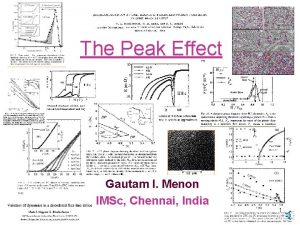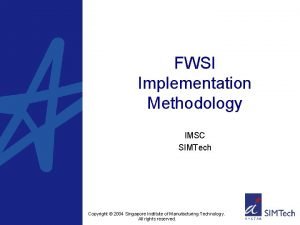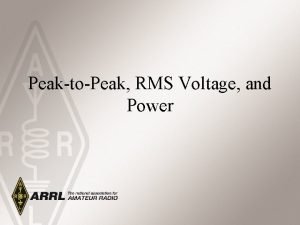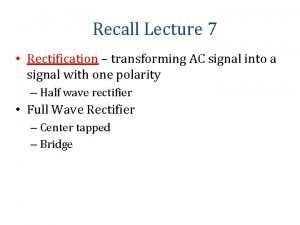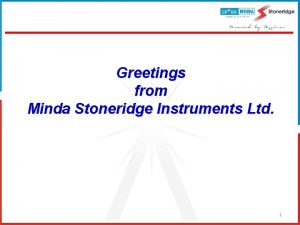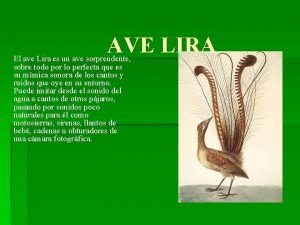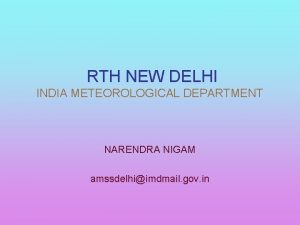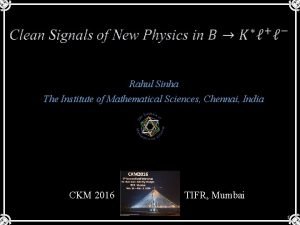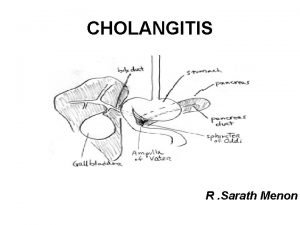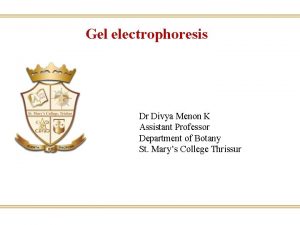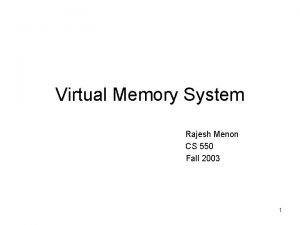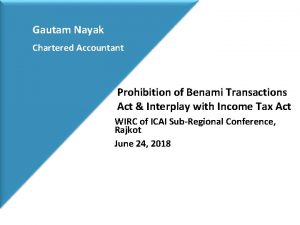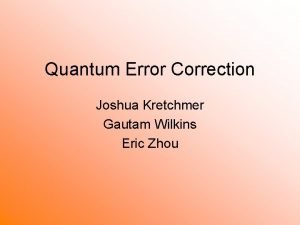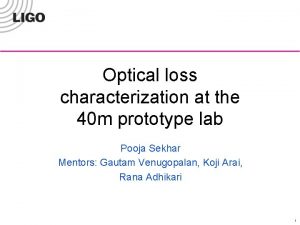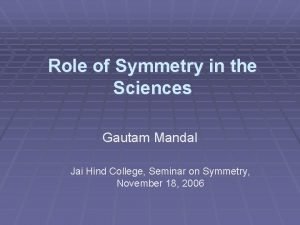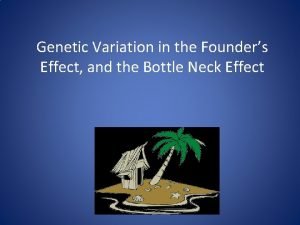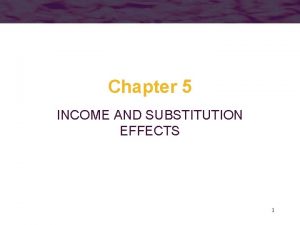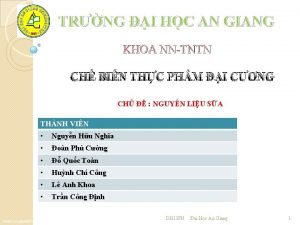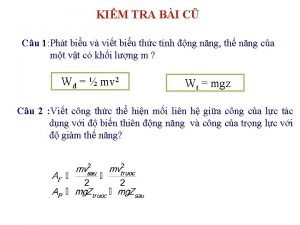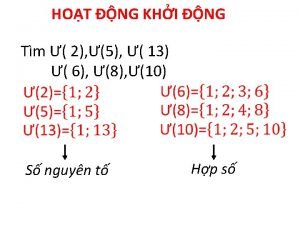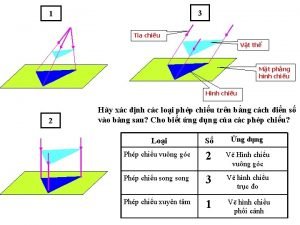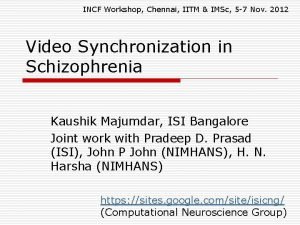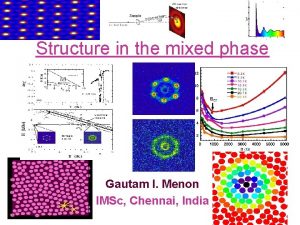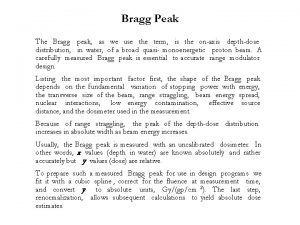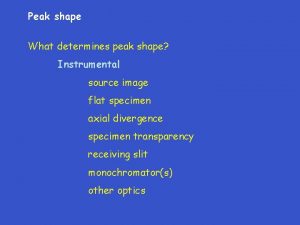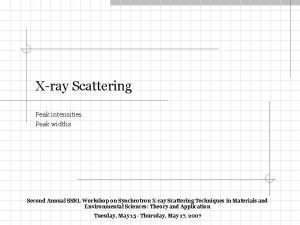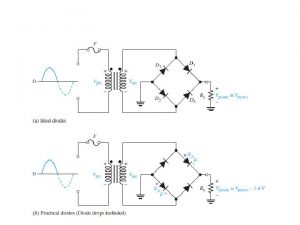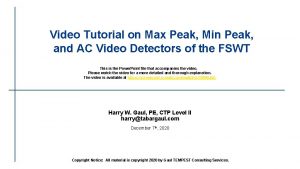The Peak Effect Gautam I Menon IMSc Chennai
























































- Slides: 56

The Peak Effect Gautam I. Menon IMSc, Chennai, India 1

Type-II Superconductivity The mixed (Abrikosov) phase of vortex lines in a type-II superconductor Structure of a vortex line The peak effect is a property of dynamics in the mixed phase 2

How are forces exerted on vortex lines? How do vortex lines move under the action of an external force? 3

Lorentz Force on Flux Lines Force/unit volume Local supercurrent density Magnetic pressure Local induction Tension along lines of force 4

Dissipation from Line Motion Viscous forces oppose motion, damping coefficient g, lines move with velocity v Competition of applied and viscous forces yields a steady state, motion of vortices produces an electric field Power dissipation from EJ, thus nonzero resistivity from flux flow 5

Random Pinning Forces • To prevent dissipation, pin lines by quenched random disorder • Line feels sum of many random forces • Summation problem: Adding effects of these random forces. How does quenched randomness affect the crystal? 6

Elasticity and Pinning compete In the experimental situation, a random potential from pinning sites The lattice deforms to accommodate to the pinning, but pays elastic energy Pinning always wins at the largest length scales: no translational long-range order (Larkin) 7

Depinning • From random pinning: critical force to set flux lines into motion • Transition from pinned to depinned state at a critical current density • Competition of elasticity, randomness and external drive 8

The Peak Effect Critical force to set the flux line system into motion The Peak Effect refers to the non-monotonic behavior of the critical force/current density as H or T are varied 9

How is this critical force computed? 10

Larkin Lengths • At large scales, disorder induced relative displacements of the lattice increase • Define Larkin lengths 11

Estimating Jc Pinning induces Larkin domains. External drive balances gain from domain formation. collective pinning theory Larkin and Ovchinnikov J. Low Temp. Phys 34 409 (1979) Role of the Larkin lengths/Larkin Volume 12

No peak effect T. G. Berlincourt, R. D. Hake and D. H. Leslie 13

Surface Plot of jc The peak effect in superconducting response Rise in critical currents implies a drop in measured resistivity 14

Why does the peak effect occur? Many explanations … 15

The Pippard Mechanism • Pippard: Softer lattices are better pinned [Phil. Mag. 34 409 (1974) • Close to Hc 2, shear modulus is vastly reduced (vanishes at Hc 2), so lines adjust better to pinning sites • Critical current increases sharply 16

PE as Phase Transition? • Shear moduli also collapse at a melting transition • Could the PE be signalling a melting transition? (In some systems …) • Disorder is crucial for the peak effect. What does disorder do to the transition? 17

Peak Effects in ac susceptibility measurements Sarkar et al. Dips in the real part of ac susceptibility translate to 18 peaks in the critical current

Will concentrate principally on transport measurements G. Ravikumar’s lecture: Magnetization, susceptibility 19

Peak Effect in Transport: 2 H-Nb. Se 2 Peak effect probed in resistivity measurements Fixed H, varying T; Fixed T varying H 20

Nonlinearity, Location A highly non-linear phenomenon Transition in relation to Hc 2 21

In-phase and out-of-phase response • Apply ac drive, measure in phase and out-ofphase response • Dip in in-phase response, peak in out-of-phase response: superconductor becomes more superconducting • Similar response probed in ac susceptibility measurements 22

Systematics of I-V Curves I-V curves away from the peak behave conventionally. Concave upwards. Such curves are nontrivially different in the peak regime 23

IV curves and their evolution Evolution of dynamics IV curves are convex upwards in the peak region Differential resistivity Peak in differential resistivity in the peak 24 region

Fingerprint effect • Differential resistivity in peak regime shows jagged structure • Reproducible: increase and lower field • Such structure absent outside the peak regime • Power-laws in IV curves outside; monotonic differential resistivity 25

Interpretation of Fingerprints? • A “Fingerprint” of the structure of disorder? • Depinning of the flux-line lattice proceeds via a series of specific and reproducible near-jumps in I-V curves • This type of finger print is the generic outcome of the breaking up of the fluxline lattice due to plastic flow in a regime intermediate between elastic and fluid flow (Higgins and Bhattacharya) 26

Noise • If plastic flow is key, flow should be noisy • Measure frequency dependence of differential resistivity in the peak region • Yes: Anomalously slow dynamics is associated with plastic flow. Occurs at small velocities and heals at large velocities where the lattice becomes more correlated. • A velocity correlation length Lv 27

Dynamic Phase Diagram • Force on y-axis, thermodynamic parameter on x-axis (non-equilibrium) • Close to the peak, a regime of plastic flow • Peak onset marks onset of plastic flow • Peak maximum is solid-fluid transition 28

Numerical Simulations • Brandt, Jensen, Berlinsky, Shi, Brass. . • Koshelev, Vinokur • Faleski, Marchetti, Middleton • Nori, Reichhardt, Olson • Scalettar, Zimanyi, Chandran. . And a whole lot more … 29

Simulations: The General Idea • • • Interaction – soft (numerically easy) or realistic Disorder, typically large number of weak pinning sites, but also correlated disorder Apply forces, overdamped eqn of motion, measure response Depinning thresholds, top defects, diff resistivity, healing defects through motion, Equilibrium aspects: the phase diagram 30

Numerical Simulations Faleski, Marchetti, Middleton: PRE (1996) Depinning as a function of pinning strengths. Differential resistivity 31 Bimodal structure of velocity distributions: Plastic flow

FMM: Velocity Distributions Velocity distributions appear to have two components 32

Chandran, Zimanyi, Scalettar (CZS) More realistic models for interactions Defect densities Hysteresis Dynamic transition in T=0 flow 33

CSZ: Flow behaviour Large regime of Disordered flow All roughly consistent with the physical ideas of the dominance of plasticity at 34 depinning

Dynamic Phase Diagram • Predict a dynamic phase transition at a characteristic current • Phase at high drives is a crystal • The crystallization current diverges as the temperature approaches the melting temperature • Fluctuating component of the pinning force acts like a “shaking temperature” . . Lots of later work Koshelev and Vinokur, PRL(94) 35

Simulations: Summary • We now know a lot more about the depinning behaviour of two-dimensional solids in a quenched disorder background. • Variety of new characterizations from the simulations of plastic flow phenomena • Dynamic phase transitions in disordered systems • Yet. . May not have told us much about the peak effect phenomenon itself 36

Return to the experiments 37

History Dependence in PE region Two distinct states of the flux-line lattice, one relatively ordered one highly disordered. Can anneal the disordered state into the ordered one Henderson, Andrei, Higgins, Bhattacharya Critical Currents differ between FC and ZFC routes 38

Peak Effect vs Peak Effect Anomalies Let us assume that the PE is a consequence of an order-disorder transition in the flux line system Given just this, how do we understand the anomalies in the peak regime? Tpl Tp The Peak Regime 39

Zeldov and collaborators: Peak Effect anomalies as a consequence of the injection of a meta-stable phase at the sample boundaries and annealing within the bulk Boundaries may play a significant role in PE physics 40

The Effects of Sample Edges • Role of barriers to flux entry and departure at sample surfaces • Bean-Livingston barrier • Currents flow near surface to ensure entry and departure of lines • Significant dissipation from surfaces 41

Corbino geometry: Zeldov and collaborators Surface effects can be eliminated by working in a Corbino geometry. Peak effect sharpens, associated with Hp 42

Relevance of Edges • Both dc and ac drives • Hall probe measurements • Measure critical currents for both ac and dc through lock-in techniques • Intermediate regime of coexistence from edge contamination 43

Direct access to currents • Map current flow using Maxwells equations and measured magnetic induction using the Hall probe method • Most of the current flows at the edges, little at the bulk • Dissipation mostly edge driven? 44

Andrei and collaborators • Start with ZFC state, ramp current up and then down • Different critical current. . • “Jumpy” behavior on first ramp • Lower threshold on subsequent ramps 46

Plastic motion/Alternating Currents • Steady state response to bi-directional pulses vs unidirectional pulses • Motion if bi-directional current even if amplitude is below the dc critical current • No response to unidirectional pulses Henderson, Andrei, Higgins 47

Memory and Reorganization I Andrei group 48

Memory and Reorganization II Response resumes where it left off Andrei group 49

Generalized Dynamic Phase Diagram More complex intermediate “Phases” in a disordered system under flow 50

Reentrant Peak Effect • Reentrant nature of the peak effect boundary at very low fields • Connection to reentrant melting? • See in both field and temperature scans • Later work by Zeldov and collaborators TIFR/BARC/WARWICK/NEC COLLABORATION 51

Phase Behaviour: Reentrant Melting 52

The phase diagram angle and a personal angle …. 54

Phase Behaviour of Disordered Type-II superconductors The conventional view The ordered phase The disordered phase 55

Phase Behaviour in the Mixed Phase The conventional picture An alternative view 57

Properties of the Phase Diagram • Peak effect associated with the sliver of glassy phase which is the continuation of the high field glassy state to low fields • Domain-like structure in the intermediate (multidomain) state • Domains can be very large for weak disorder and high temperature • A generic two-step transition Lots of very suggestive data from TIFR/BARC etc 58

The Last Word. . • Alternative approaches: Critical currents may be dominated by surface pinning, effects of surface treatment (Simon/Mathieu). PE seems to survive, though • How to compute the transport properties of the multi-domain glass? • If the Zeldov et al. disordered phase injection at surfaces scenario is correct, what about the simulations? • More theory which is experiment directed • Other peak effects without transitions? 59
 Gautam menon imsc
Gautam menon imsc Imsc singapore
Imsc singapore Rms to peak
Rms to peak Peak to peak voltage
Peak to peak voltage Widows peak dominant or recessive
Widows peak dominant or recessive Single column l&t head office chennai
Single column l&t head office chennai Minda stoneridge instruments ltd
Minda stoneridge instruments ltd Plumbing company profile
Plumbing company profile Autolib chennai
Autolib chennai K vaitheeswaran advocate
K vaitheeswaran advocate Kk nagar esi hospital facilities
Kk nagar esi hospital facilities Silva y lira
Silva y lira Amss chennai data transmission
Amss chennai data transmission Animal quarantine certificate format
Animal quarantine certificate format Jfarmindia
Jfarmindia Viov12
Viov12 Dr sarath menon
Dr sarath menon Dr divya menon
Dr divya menon Memory management
Memory management Dr geetha menon
Dr geetha menon Venu menon md
Venu menon md Dr asha menon
Dr asha menon Bourgeoisie definition
Bourgeoisie definition Sanjay gautam nayak
Sanjay gautam nayak Joshua kretchmer
Joshua kretchmer Dipendra gautam
Dipendra gautam Gautam venugopalan
Gautam venugopalan Gautam shroff tcs
Gautam shroff tcs Gautam mandal tifr
Gautam mandal tifr Dr gautam goswami
Dr gautam goswami Why do you feel proud of mt everest and gautam buddha
Why do you feel proud of mt everest and gautam buddha Gautam das uta
Gautam das uta Bohr's effect in respiration
Bohr's effect in respiration Founder effect vs bottleneck effect
Founder effect vs bottleneck effect Slutsky equation
Slutsky equation Vẽ hình chiếu đứng bằng cạnh của vật thể
Vẽ hình chiếu đứng bằng cạnh của vật thể đại từ thay thế
đại từ thay thế Quá trình desamine hóa có thể tạo ra
Quá trình desamine hóa có thể tạo ra Các môn thể thao bắt đầu bằng tiếng nhảy
Các môn thể thao bắt đầu bằng tiếng nhảy Công thức tính độ biến thiên đông lượng
Công thức tính độ biến thiên đông lượng Hát kết hợp bộ gõ cơ thể
Hát kết hợp bộ gõ cơ thể Sự nuôi và dạy con của hổ
Sự nuôi và dạy con của hổ Thế nào là mạng điện lắp đặt kiểu nổi
Thế nào là mạng điện lắp đặt kiểu nổi Các loại đột biến cấu trúc nhiễm sắc thể
Các loại đột biến cấu trúc nhiễm sắc thể Biện pháp chống mỏi cơ
Biện pháp chống mỏi cơ Phản ứng thế ankan
Phản ứng thế ankan Chó sói
Chó sói Thiếu nhi thế giới liên hoan
Thiếu nhi thế giới liên hoan điện thế nghỉ
điện thế nghỉ Một số thể thơ truyền thống
Một số thể thơ truyền thống Thế nào là hệ số cao nhất
Thế nào là hệ số cao nhất Trời xanh đây là của chúng ta thể thơ
Trời xanh đây là của chúng ta thể thơ Lp html
Lp html Hệ hô hấp
Hệ hô hấp Các số nguyên tố
Các số nguyên tố đặc điểm cơ thể của người tối cổ
đặc điểm cơ thể của người tối cổ Tia chieu sa te
Tia chieu sa te
